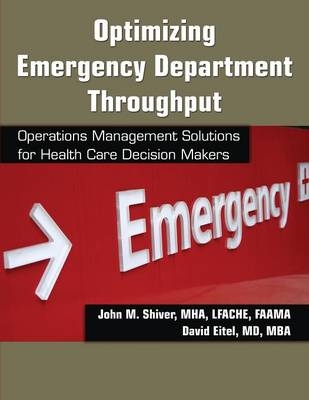
Optimizing Emergency Department Throughput
Productivity Press (Verlag)
978-1-4200-8377-4 (ISBN)
Across the country ambulances are turned away from emergency departments (EDs) and patients are waiting hours and sometimes days to be admitted to a hospital room. Hospitals are finding it hard to get specialist physicians to come to treat emergency patients. Our EDs demand a new way of thinking. They are not at a tipping point; they are at a breaking point. Under current loads and trends they are going to begin to break and these breakdowns will be painful and ultimately dangerous to society.
Recognizing that the ideal in health care is presently beyond our immediate grasp, this book instead focuses on providing health care leaders with the tools they can employ to optimize the performance of EDs and thereby improve service to patients, employees, and communities.
Written by 20 of the most progressive and successful health care reformers in the country, the approaches described can be utilized to quantify improvements, enhance predictability of workflow, and improve staff scheduling. The data derived using these techniques can serve as powerful evidence in support of change. While a common discussion among ED professionals is the perception that many patients are not really emergency patients and could be treated in another setting at another time, that argument is not germane until we as a nation elect to reform the way we chose to deliver healthcare to the underserviced.
In the meantime this book provides invalauable information to help individual hospitals to retool their ED’s. It offers new approaches that think outside of the box for all stakeholders. It also provides the statistical evidence that administrators need to make their cases for changes and added resources. It will help you forecast the demand for services and give your center an approach that will allow the ED to become a source of income rather than one that continues to hemorrhage needed limited health care funding.
College of Health and Human Services, George Mason University, Fairfax, VA, USA
Introduction: Description of Current Status of Emergency Departments and Hospitals. Fixing the Front End: Why Would an Emergency Department Medical Director or Nursing Supervisor Wish to Install Emergency Severity Index (ESI) Triage? Process Mapping and Workflow Diagramming in Health Care. What is Lean Six Sigma? An Introduction to Lean and Six Sigma for the Health Care Novice. Using Lean-Six Sigma to Accelerate Emergency Department Results. Queuing Models for Hospital Emergency Departments. The Nursing Perspective and Role in Planning a Simulation Modeling Project: Historical, Experiential, and Future Applications of Complex Adaptive Systems Thinking; with an Emergency Department Case Study. The Physiology of Service Capacity. The Door-to-Doc Toolkit: Planning Emergency Department Capacity for Delivering Safe Care. Forecasting the Demand for Emergency Department Services. Improving Fairness in Nurse Scheduling: Introducing a New Approach Using Auctions and Integer Programming Optimization. Establishing Engineered Nurse Staffing Requirements in the Emergency Department. Patient Safety Organizations: A New Paradigm in Quality Management and Communication Systems in Health Care. Alternative Emergency Care Settings. Appendix A : Case Study—Surviving and Thriving in Emergency Department Chaos. Appendix B. About the Editors. About the Contributors.
| Erscheint lt. Verlag | 7.1.2010 |
|---|---|
| Zusatzinfo | 16 Tables, black and white; 73 Illustrations, black and white |
| Verlagsort | Portland |
| Sprache | englisch |
| Maße | 219 x 276 mm |
| Gewicht | 480 g |
| Themenwelt | Medizin / Pharmazie ► Gesundheitswesen |
| ISBN-10 | 1-4200-8377-5 / 1420083775 |
| ISBN-13 | 978-1-4200-8377-4 / 9781420083774 |
| Zustand | Neuware |
| Haben Sie eine Frage zum Produkt? |
aus dem Bereich


